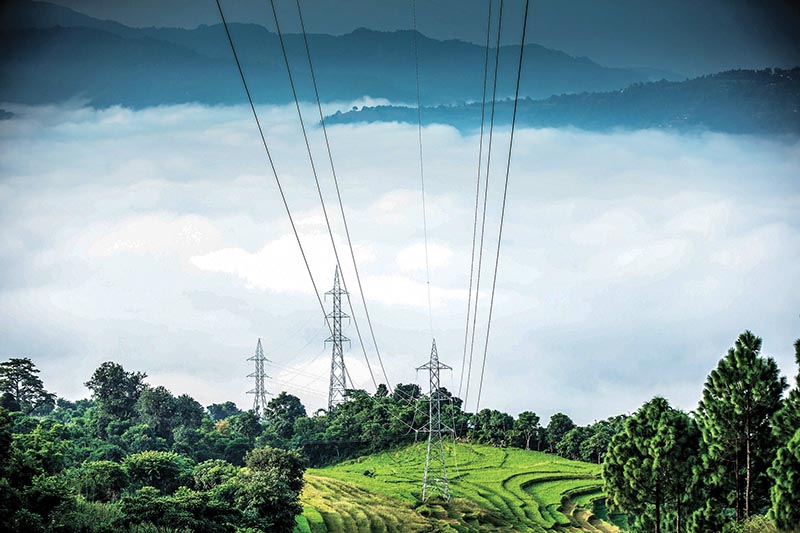Ample prospects for hydropower development in the country
Kathmandu, January 4
The energy consumption of Nepal has been increasing every year. However, consumption of traditional energy sources like firewood, animal dung and dry leaves account for almost 80 per cent of the total energy consumed in the country. Similarly, use of petroleum products as energy sources is also high in the country.
Meanwhile, hydro energy contributes to merely 3.7 per cent of the total energy consumption in Nepal, reflecting the prospect of development of hydropower sector in the country. Besides this, Nepal's dependence on India to fulfil seasonal electricity deficit and shift in household energy use from tradition biomass energy to modern energy also echo the prospect of hydro energy in the country.
Growing fuel demand
Import of petroleum products in the country has been increasing by an average of 15 per cent every year, as per Nepal Oil Corporation (NOC).
In fact, fuel is the highest commodity that Nepal imports as the country does not have any petroleum source and its import is the major factor behind the ballooning trade deficit of Nepal. This surging import of petroleum products in Nepal not only proves the country's dependence on fuel to meet energy demand but also points to the prospect for hydro energy.
If Nepal wants to narrow down its trade deficit, a major step would be to reduce fuel import and promote hydro energy. As liquefied petroleum gas (LPG) and diesel are being used as the major sources for households and in the industrial sector, respectively, different researches have revealed that Nepal could save billions of rupees if the country were able to substitute fuel energy by hydro energy.
A research carried out by Amrit Man Nakarmi, professor at Patan Engineering Campus, showed that Nepal can save up to Rs 37 billion in a year that is used for importing cooking gas if the country substitutes household energy consumption with hydro electricity.
Industrialisation
Though tepidly, Nepal is in the process of industrialisation. As mentioned earlier, domestic industries have been highly consuming diesel for energy due to lack of adequate electricity supply to industries.
As per Pashupati Murarka, immediate past president of the Federation of Nepalese Chambers of Commerce and Industry, more than 30 per cent of the demand for energy in domestic industries is fulfilled by fossil fuels. However, Murarka said that hydro energy is slowly substituting fossil fuels in domestic industries with regular supply of electricity from the government in recent months.
“Due to lack of adequate hydro energy, industries have been forced to opt for petroleum products to fulfil their energy needs, which is costlier,” said Murarka.
According to him, while electricity supplied by the government costs almost Rs 9.5 per unit, production cost of energy using diesel comes to almost Rs 20 per unit for industries.
Thus, hydro energy has a wide market in the country's industrial and manufacturing sectors.
Electric vehicle promotion
Nepal has recently adopted a policy to promote electric vehicles (EVs).
As a majority of fuel imported in the country is consumed by vehicles, realising the government's plan to substitute fuel-guzzling vehicles with electric vehicles will certainly boost the morale of hydro developers of the country.
The market for EVs in Nepal is gradually increasing with few electric vehicle companies entering into the business and government also prioritising EVs.
While the government has been providing tax incentives on the import of EVs, Nepal Electricity Authority (NEA) has recently adopted policies to operate charging stations for EVs in different locations. Thus it is clear that the rise of the EV industry in Nepal will increase the prospects for hydro energy in the country.
Seasonal energy deficit
Though hydro electricity production in the country is increasing every year, Nepal still depends on India to meet the seasonal deficit of electricity.
As most of the hydropower projects in the country are run-of-the-river type, their generation capacity drops to one-third of their installed capacity during the winter months when the water levels in the rivers recede. Thus, NEA imports around 372 megawatts of electricity (equivalent to Nepal's total electricity production in the winter months) from India during the dry season to cater to the domestic electricity demand.
Therefore, there is ample space to increase production of hydroelectricity and substitute electricity import from India. Moreover, if the country manages to generate surplus energy, it could trade electricity with its energy-starved neighbours, which could be a boon for the country's economy.






